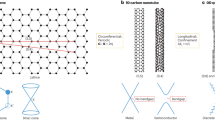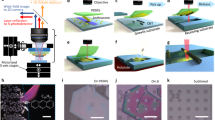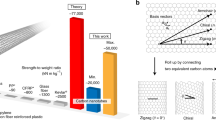Abstract
Nanotubes show great promise for miniaturizing advanced technologies. Their exceptional physical properties are intimately related to their morphological and crystal structure. Circumferential faceting of multiwalled nanotubes reinforces their mechanical strength and alters their tribological and electronic properties. Here, the nature of this important phenomenon is fully rationalized in terms of interlayer registry patterns. Regardless of the nanotube identity (that is, diameter, chirality, chemical composition), faceting requires the matching of the chiral angles of adjacent layers. Above a critical diameter that corresponds well with experimental results, achiral multiwalled nanotubes display evenly spaced extended axial facets whose number equals the interlayer difference in circumferential unit cells. Elongated helical facets, commonly observed in experiment, appear in nanotubes that exhibit small interlayer chiral angle mismatch. When the wall chiralities are uncorrelated, faceting is suppressed and outer layer corrugation, which is induced by the Moiré superlattice, is obtained in agreement with experiments. Finally, we offer an explanation for the higher incidence of faceting in multiwalled boron nitride nanotubes with respect to their carbon-based counterparts.
This is a preview of subscription content, access via your institution
Access options
Subscribe to this journal
Receive 12 print issues and online access
$259.00 per year
only $21.58 per issue
Buy this article
- Purchase on Springer Link
- Instant access to full article PDF
Prices may be subject to local taxes which are calculated during checkout



Similar content being viewed by others
References
Liu, M. & Cowley, J. M. Structures of the helical carbon nanotubes. Carbon 32, 393–403 (1994).
Gogotsi, Y., Libera, J. A., Kalashnikov, N. & Yoshimura, M. Graphite polyhedral crystals. Science 290, 317–320 (2000).
Zhang, G., Jiang, X. & Wang, E. Tubular graphite cones. Science 300, 472–474 (2003).
Zhang, G. Y., Bai, X. D., Wang, E. G., Guo, Y. & Guo, W. Monochiral tubular graphite cones formed by radial layer-by-layer growth. Phys. Rev. B 71, 113411 (2005).
Celik-Aktas, A., Zuo, J. M., Stubbins, J. F., Tang, C. C. & Bando, Y. Double-helix structure in multiwall boron nitride nanotubes. Acta Crystallogr. Sect. A 61, 533–541 (2005).
Golberg, D., Mitome, M., Bando, Y., Tang, C. C. & Zhi, C. Y. Multi-walled boron nitride nanotubes composed of diverse cross-section and helix type shells. Appl. Phys. A 88, 347–352 (2007).
Garel, J. et al. Ultrahigh torsional stiffness and strength of boron nitride nanotubes. Nano Lett. 12, 6347–6352 (2012).
Garel, J. et al. BCN nanotubes as highly sensitive torsional electromechanical transducers. Nano Lett. 14, 6132–6137 (2014).
Nigues, A., Siria, A., Vincent, P., Poncharal, P. & Bocquet, L. Ultrahigh interlayer friction in multiwalled boron nitride nanotubes. Nat. Mater. 13, 688–693 (2014).
Golberg, D. et al. Boron nitride nanotubes and nanosheets. ACS Nano 4, 2979–2993 (2010).
De Volder, M. F. L., Tawfick, S. H., Baughman, R. H. & Hart, A. J. Carbon nanotubes: present and future commercial applications. Science 339, 535–539 (2013).
Arash, B., Wang, Q. & Varadan, V. K. Mechanical properties of carbon nanotube/polymer composites. Sci. Rep. 4, 6479 (2014).
Yoon, M., Howe, J., Tibbetts, G., Eres, G. & Zhang, Z. Polygonization and anomalous graphene interlayer spacing of multi-walled carbon nanofibers. Phys. Rev. B 75, 165402 (2007).
Golovaty, D. & Talbott, S. Continuum model of polygonization of carbon nanotubes. Phys. Rev. B 77, 081406(R) (2008).
Tibbetts, K., Doe, R. & Ceder, G. Polygonal model for layered inorganic nanotubes. Phys. Rev. B 80, 014102 (2009).
Mu, W., Zhang, G. & Ou-Yang, Z. Spontaneous polygonization of multiwalled carbon nanotubes: perturbation analysis. Jpn. J. Appl. Phys. 51, 065101 (2012).
Palser, A. H. R. Interlayer interactions in graphite and carbon nanotubes. Phys. Chem. Chem. Phys. 1, 4459–4464 (1999).
Hod, O. Quantifying the stacking registry matching in layered materials. Isr. J. Chem. 50, 506–514 (2010).
Koshino, M., Moon, P. & Son, Y.-W. Incommensurate double-walled carbon nanotubes as one-dimensional moiré crystals. Phys. Rev. B 91, 035405 (2015).
Kolmogorov, A. N. & Crespi, V. H. Smoothest bearings: interlayer sliding in multiwalled carbon nanotubes. Phys. Rev. Lett. 85, 4727–4730 (2000).
Hashimoto, A. et al. Atomic correlation between adjacent graphene layers in double-wall carbon nanotubes. Phys. Rev. Lett. 94, 045504 (2005).
Schouteden, K., Volodin, A., Li, Z. & Van Haesendonck, C. Atomically resolved Moiré-type superstructures in double-walled carbon nanotubes. Carbon 61, 379–385 (2013).
Hod, O. Graphite and hexagonal boron-nitride have the same interlayer distance. Why? J. Chem. Theory and Comput. 8, 1360–1369 (2012).
Golberg, D. et al. Fine structure of boron nitride nanotubes produced from carbon nanotubes by a substitution reaction. J. Appl. Phys. 86, 2364–2366 (1999).
Golberg, D., Bando, Y., Kurashima, K. & Sato, T. Ropes of BN multi-walled nanotubes. Solid State Commun. 116, 1–6 (2000).
Celik-Aktas, A., Zuo, J. M., Stubbins, J. F., Tang, C. & Bando, Y. Structure and chirality distribution of multiwalled boron nitride nanotubes. Appl. Phys. Lett. 86, 133110 (2005).
Xu, Z., Bai, X., Wang, Z. L. & Wang, E. Multiwall carbon nanotubes made of monochirality graphite shells. J. Am. Chem. Soc. 128, 1052–1053 (2006).
Zuo, J. M., Vartanyants, I., Gao, M., Zhang, R. & Nagahara, L. A. Atomic resolution imaging of a carbon nanotube from diffraction intensities. Science 300, 1419–1421 (2003).
Li, F. et al. Identification of the constituents of double-walled carbon nanotubes using Raman spectra taken with different laser-excitation energies. J. Mater. Res. 18, 1251–1258 (2003).
Koziol, K., Shaffer, M. & Windle, A. Three-dimensional internal order in multiwalled carbon nanotubes grown by chemical vapor deposition. Adv. Mater. 17, 760–763 (2005).
Ducati, C. et al. Crystallographic order in multi-walled carbon nanotubes synthesized in the presence of nitrogen. Small 2, 774–784 (2006).
Hirahara, K. et al. Chirality correlation in double-wall carbon nanotubes as studied by electron diffraction. Phys. Rev. B 73, 195420 (2006).
Gao, M., Zuo, J. M., Zhang, R. & Nagahara, L. A. Structure determinations of double-wall carbon nanotubes grown by catalytic chemical vapor deposition. J. Mater. Sci. 41, 4382–4388 (2006).
Guan, L., Suenaga, K. & Iijima, S. Smallest carbon nanotube assigned with atomic resolution accuracy. Nano Lett. 8, 459–462 (2008).
Guo, W. & Guo, Y. Energy optimum chiralities of multiwalled carbon nanotubes. J. Am. Chem. Soc. 129, 2730–2731 (2007).
Liu, K. H. et al. Van der Waals-coupled electronic states in incommensurate double-walled carbon nanotubes. Nat. Phys. 10, 737–742 (2014).
Tersoff, J. Modeling solid-state chemistry—interatomic potentials for multicomponent systems. Phys. Rev. B 39, 5566–5568 (1989).
Stuart, S. J., Tutein, A. B. & Harrison, J. A. A reactive potential for hydrocarbons with intermolecular interactions. J. Chem. Phys. 112, 6472 (2000).
Lindsay, L. & Broido, D. A. Optimized Tersoff and Brenner empirical potential parameters for lattice dynamics and phonon thermal transport in carbon nanotubes and graphene. Phys. Rev. B 81, 205441 (2010).
Kolmogorov, A. N. & Crespi, V. H. Registry-dependent interlayer potential for graphitic systems. Phys. Rev. B 71, 235415 (2005).
Sevik, C., Kinaci, A., Haskins, J. B. & Çağın, T. Characterization of thermal transport in low-dimensional boron nitride nanostructures. Phys. Rev. B 84, 085409 (2011).
Leven, I., Azuri, I., Kronik, L. & Hod, O. Inter-layer potential for hexagonal boron nitride. J. Chem. Phys. 140, 104106 (2014).
Marom, N. et al. Stacking and registry effects in layered materials: the case of hexagonal boron nitride. Phys. Rev. Lett. 105, 046801 (2010).
Hod, O. Interlayer commensurability and superlubricity in rigid layered materials. Phys. Rev. B 86, 075444 (2012).
Hod, O. The registry index: a quantitative measure of materials’ interfacial commensurability. ChemPhysChem 14, 2376–2391 (2013).
Acknowledgements
O.H. acknowledges the Lise-Meitner Minerva Center for Computational Quantum Chemistry and the Center for Nanoscience and Nanotechnology at Tel-Aviv University for their generous financial support. Work in Trieste was carried out under ERC Grant 320796 MODPHYSFRICT. EU COST Action MP1303 is also gratefully acknowledged.
Author information
Authors and Affiliations
Contributions
I.L. and R.G. coded the relevant force-fields, performed the geometry optimizations and actively participated in the analysis of the results and the writing of the manuscript. I.L. and O.H. coded the unrolled nanotube registry pattern analysis tool and analysed the corresponding results. E.T., A.V. and O.H. guided the research and data analysis and led the writing of the manuscript.
Corresponding author
Ethics declarations
Competing interests
The authors declare no competing financial interests.
Supplementary information
Supplementary information
Supplementary information (PDF 1357 kb)
Rights and permissions
About this article
Cite this article
Leven, I., Guerra, R., Vanossi, A. et al. Multiwalled nanotube faceting unravelled. Nature Nanotech 11, 1082–1086 (2016). https://doi.org/10.1038/nnano.2016.151
Received:
Accepted:
Published:
Issue Date:
DOI: https://doi.org/10.1038/nnano.2016.151
This article is cited by
-
Regulating Rolling and Sliding of Carbon Nanotubes on Graphite Through Doping and Charging
Tribology Letters (2022)
-
Four-dimensional vibrational spectroscopy for nanoscale mapping of phonon dispersion in BN nanotubes
Nature Communications (2021)
-
Structural lubricity in soft and hard matter systems
Nature Communications (2020)
-
Structural superlubricity and ultralow friction across the length scales
Nature (2018)
-
Sliding friction of graphene/hexagonal –boron nitride heterojunctions: a route to robust superlubricity
Scientific Reports (2017)



